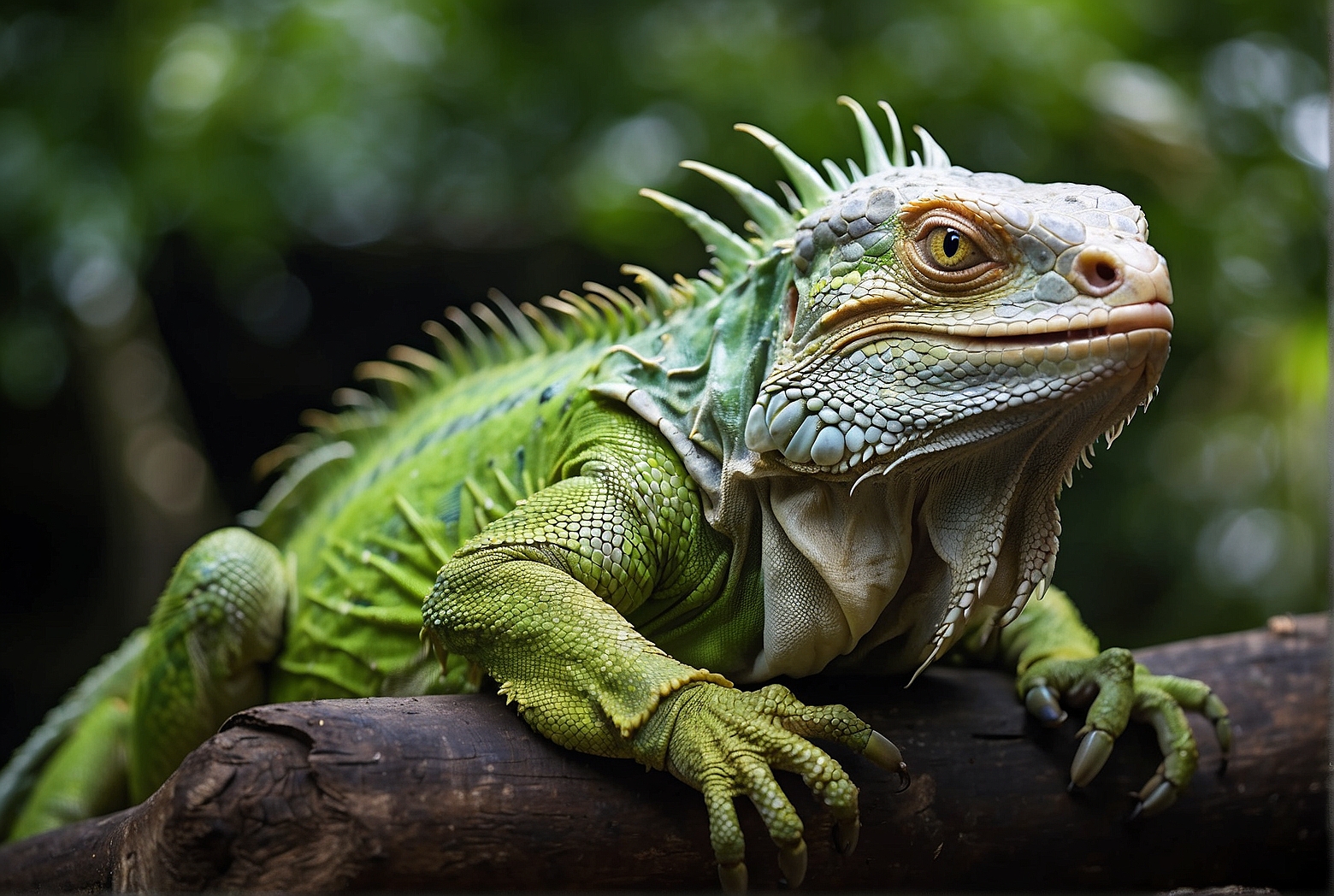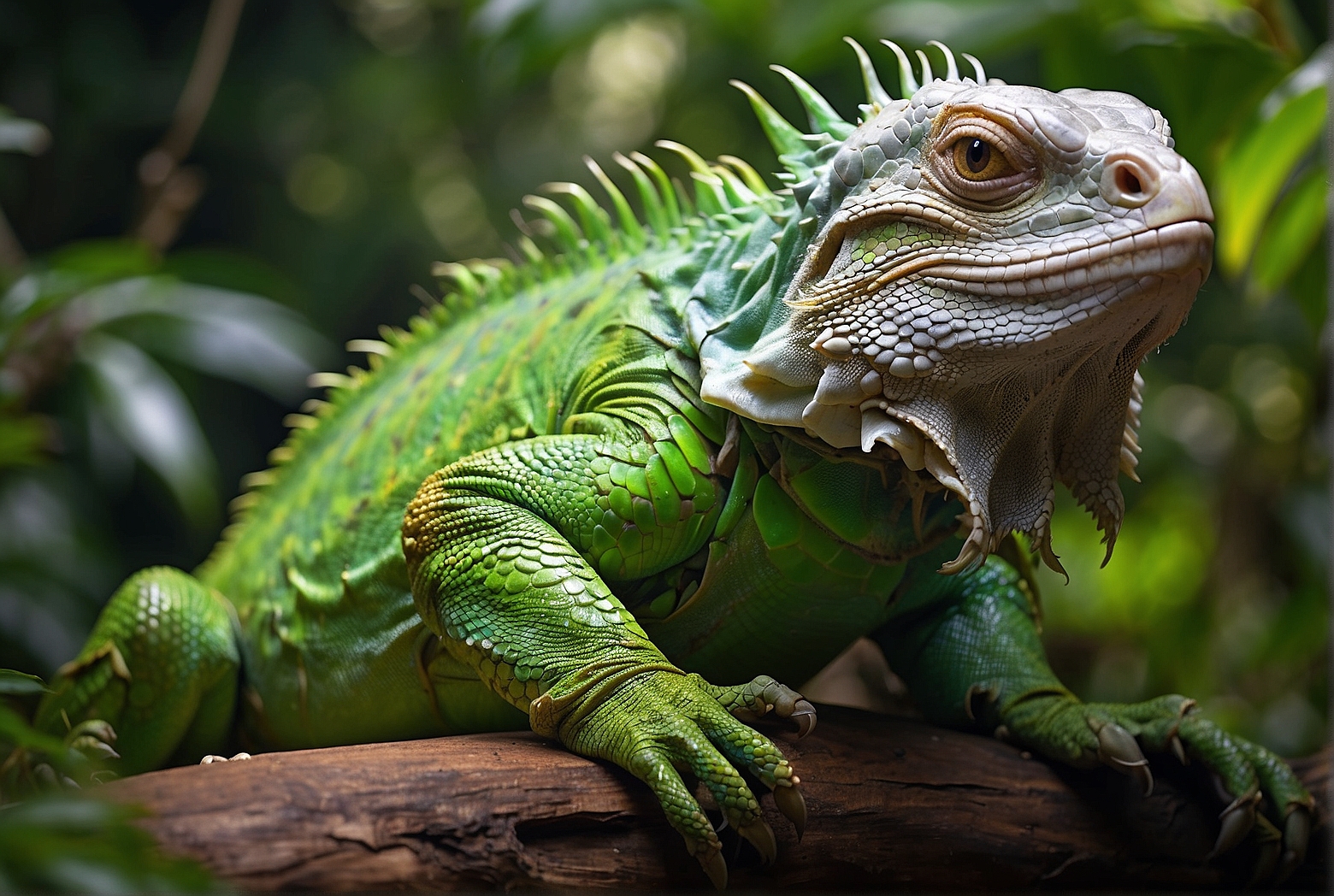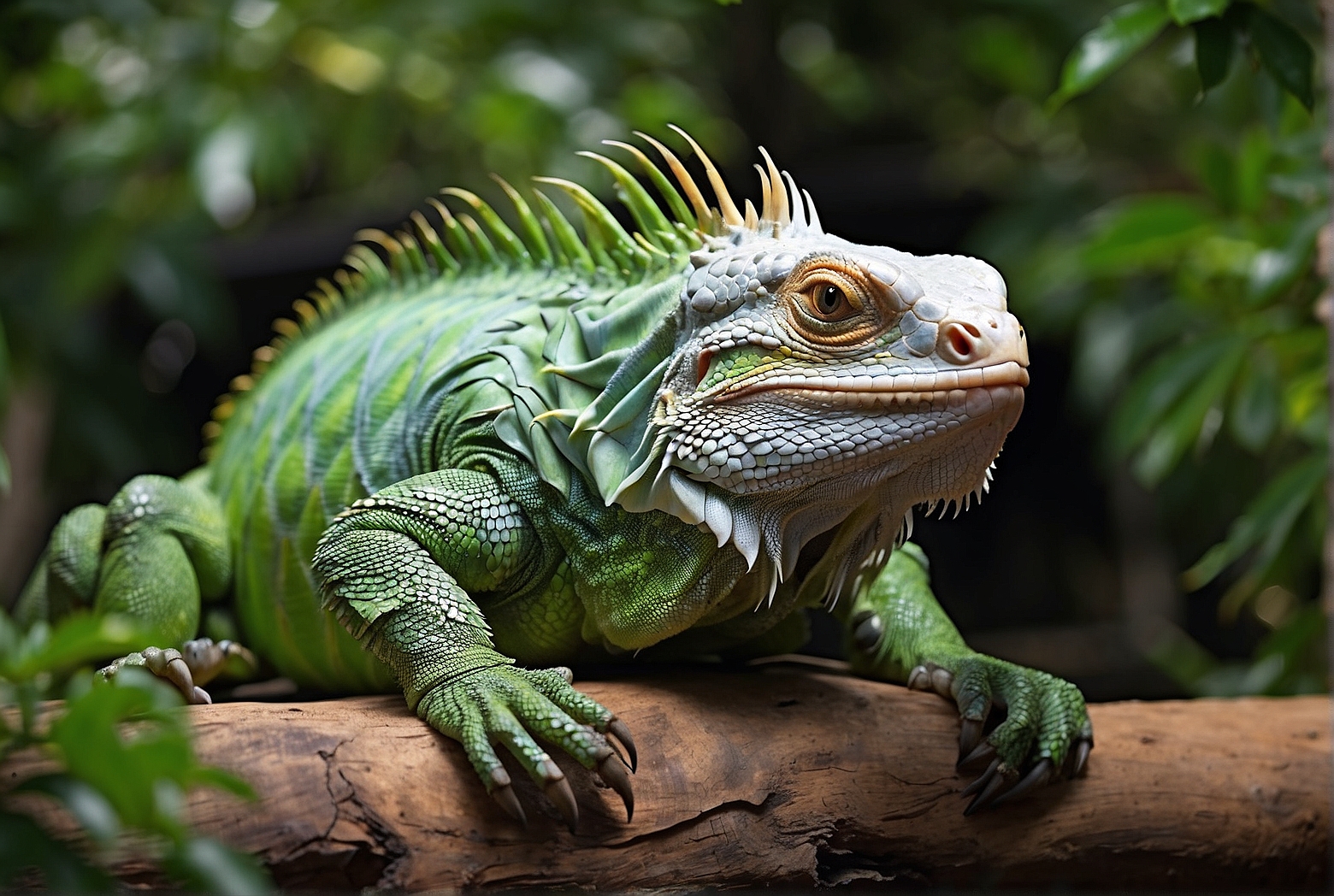In this informative article, you will discover everything you need to know about the diet of green iguanas in captivity. Whether you are a proud owner of a green iguana or considering getting one, understanding their dietary needs is essential for their health and well-being. From the perfect balance of leafy greens and vegetables to the occasional treat, we will guide you through the intricacies of providing a nutritious and varied diet for your green iguana in captivity. So, get ready to become an expert on what it takes to keep your scaly friend happy and healthy!
Understanding the Green Iguana Diet
Green iguanas are herbivorous reptiles that require a specific diet in order to thrive in captivity. Understanding their basic dietary requirements, the importance of a varied diet, and the need for calcium and vitamin supplements is crucial for the well-being of these fascinating creatures.
Basic dietary requirements
Green iguanas primarily require a diet rich in plant matter. They are not able to digest animal proteins effectively and should be fed a predominantly vegetarian diet. Their diet should consist of a variety of vegetables, fruits, dark leafy greens, and squash or root vegetables.
Importance of varied diet
A varied diet is essential for green iguanas as it ensures that they receive a wide range of nutrients necessary for their optimal health. By providing a diverse selection of vegetables and fruits, you can prevent nutritional deficiencies and promote overall well-being in your iguana.
Calcium and vitamin supplements
Supplementing your iguana’s diet with calcium and vitamins is crucial to prevent potential health issues. Green iguanas require a significant amount of calcium for proper bone growth and development. Vitamin supplements, such as vitamin D3, are also necessary to aid in the absorption of calcium. Consult with a veterinarian to determine the appropriate supplements and dosage for your iguana.
Feeding a Balanced Diet
To ensure that your green iguana receives a well-balanced diet, it is important to introduce a variety of vegetables, fruits, dark leafy greens, and squash or root vegetables into their daily meals.

Vegetables and fruits
Include a range of vegetables and fruits in your iguana’s diet to provide different flavors and textures. Some suitable options include bell peppers, carrots, broccoli, apples, and berries. It is important to wash and chop the produce into small pieces to make it easier for your iguana to consume.
Dark leafy greens
Dark leafy greens, such as kale, collard greens, and dandelion greens, are excellent sources of essential vitamins and minerals for your iguana. These greens should constitute a significant portion of their daily diet, as they contribute to a well-rounded and nutritious meal plan.
Squash and root vegetables
Including squash and root vegetables, like butternut squash or sweet potatoes, can provide your iguana with extra nutrients and hydration. These vegetables offer a different taste profile and can be a welcome addition to their diet when given in moderation.
Protein in the Diet
While green iguanas are primarily herbivores, they still require small amounts of protein in their diet. Protein contributes to essential bodily functions, such as tissue repair and maintenance. It is important to offer suitable sources of protein to meet their dietary needs.
Sources of protein
Suitable sources of protein for green iguanas include insects, worms, and commercial iguana diets specifically designed to provide the necessary amount of protein. However, it is crucial to offer protein sparingly and in moderation, as excess protein can lead to various health issues in iguanas.
Insects and worms
When incorporating insects and worms into your iguana’s diet, it is essential to ensure that they are properly gut-loaded. Gut-loading involves feeding the insects with a nutritious diet before offering them to your iguana, ensuring that they are a valuable protein source. Crickets, mealworms, and earthworms are some suitable options.

Commercial iguana diets
Some commercially available iguana diets are formulated to meet the nutritional requirements of green iguanas. These diets are typically enriched with essential vitamins and minerals, including the necessary amount of protein. However, it is important to consult with a veterinarian to determine the suitability and reliability of these commercial diets.
Hydration Needs
Providing proper hydration is crucial for the overall health and well-being of green iguanas. While these reptiles obtain some hydration from the water content in their food, it is essential to offer additional water sources and maintain a suitable level of humidity in their enclosure.
Importance of water
Water is necessary for various physiological functions in green iguanas, including digestion, maintaining body temperature, and hydration. Dehydration can lead to severe health complications, so it is vital to ensure that your iguana has access to clean and fresh water at all times.
Providing water sources
Provide a shallow water dish or bowl that your iguana can easily access. Ensure that the dish is large enough for them to soak in if they desire. It is important to regularly clean and refill the water dish to maintain hygiene and prevent the growth of harmful bacteria.
Misting and spraying
Green iguanas also benefit from regular misting or spraying to maintain optimal humidity levels. This can be achieved by using a spray bottle or a misting system to create a fine mist of water in their enclosure. Misting not only aids in hydration but also provides your iguana with the opportunity to engage in natural behaviors, such as licking droplets off leaves.
Gut-loading and Dusting Insects
If you choose to include insects in your iguana’s diet, it is essential to enhance their nutritional value through gut-loading and dusting with supplements. This ensures that your iguana receives the maximum benefit from these protein-rich treats.
Enhancing insect nutrition
Gut-loading involves feeding the insects a nutritious diet to increase their nutritional content before feeding them to your iguana. By offering the insects a balanced diet rich in vitamins and minerals, you improve their nutritional profile and subsequently provide greater nutritional value to your iguana.
Feeding insects to the iguana
When offering gut-loaded insects to your iguana, it is important to ensure that they are appropriately sized for their consumption. Insects should be smaller than the space between your iguana’s eyes, as larger prey may be challenging to swallow and digest.
Dusting insects with supplements
To further enhance the nutritional value of insects, you can dust them with calcium or vitamin supplements. Dusting involves lightly coating the insects in the supplement powder before feeding them to your iguana. This helps ensure that your iguana receives the necessary amount of vitamins and minerals alongside their protein intake.
Avoiding Harmful Foods
To keep your green iguana healthy, it is crucial to avoid feeding them toxic plants and foods that offer minimal nutritional value. Additionally, it is important to be cautious of overfeeding high-sugar foods and foods with excessive phosphorus.
Toxic plants and foods
Some plants and foods can be toxic or harmful to green iguanas. Avoid feeding them avocado, rhubarb, onions, some citrus fruits, and any plants that may be toxic in nature. It is recommended to research and familiarize yourself with a comprehensive list of toxic plants and foods to ensure your iguana’s safety.
High sugar and low nutritional value foods
Foods high in sugar, such as overly ripe fruits or processed sweets, should be avoided as they can contribute to obesity and other health issues in iguanas. Similarly, foods with low nutritional value, such as iceberg lettuce, offer little benefit to your iguana’s overall health and should be limited.
Foods with excessive phosphorus
Excessive phosphorus can disrupt calcium absorption in green iguanas, leading to metabolic bone disease. Avoid feeding foods high in phosphorus, such as spinach and beet greens, in large quantities. Instead, focus on providing a well-balanced diet that ensures an appropriate calcium-to-phosphorus ratio.
Establishing a Feeding Schedule
Establishing a consistent feeding schedule is essential for maintaining your iguana’s health and well-being. Determining their feeding frequency, maintaining consistency, and adapting the diet to their age and health requirements are key factors to consider.
Determining iguana’s feeding frequency
The frequency of feeding your green iguana depends on their age and specific needs. Juvenile iguanas require more frequent feedings, often multiple times a day, to support their rapid growth. As they mature, the feeding frequency can be reduced to once or twice a day, depending on their appetite and activity level.
Consistency and routine
Green iguanas thrive on routine and consistency. Try to establish regular feeding times and stick to them as much as possible. This helps create a sense of security for your iguana and ensures that they receive their meals at consistent intervals.
Adapting diet to age and health
As your iguana grows older, their dietary needs may change. They may require adjustments in the types and quantities of food they consume. Additionally, if your iguana has specific health conditions, such as metabolic bone disease, you may need to consult with a veterinarian and make dietary modifications accordingly.
Monitoring Weight and Health
Regularly monitoring your green iguana’s weight and observing for signs of malnutrition or overfeeding are crucial aspects of responsible iguana care. Keep track of their weight, be vigilant for potential health issues, and seek veterinary advice when necessary.
Regular weigh-ins
Weigh your iguana regularly to track their weight and overall body condition. Sudden weight loss or gain can indicate underlying health problems or improper feeding practices. Weigh your iguana using a digital scale specifically designed for reptiles and record the results to monitor any changes over time.
Signs of malnutrition or overfeeding
Be attentive to signs of malnutrition or overfeeding in your iguana. Malnutrition may present as weight loss, decreased appetite, lethargy, or changes in skin and scale condition. Overfeeding can lead to obesity, which may manifest as weight gain, difficulty moving, or excessive fat deposits. If you observe any of these signs, seek veterinary guidance to address the issue promptly.
Seeking veterinary advice
If you have concerns about your green iguana’s diet, weight, or overall health, it is important to consult with a reptile veterinarian. They can provide valuable guidance on proper dietary practices, offer personalized recommendations based on your iguana’s specific needs, and address any health concerns that may arise.
Feeding Techniques
In addition to providing a well-balanced diet, utilizing appropriate feeding techniques can enhance the feeding experience for your green iguana and contribute to their overall well-being.
Hand-feeding vs. dish-feeding
Hand-feeding allows for a more interactive feeding experience and can facilitate positive interactions between you and your iguana. It is important to ensure that your iguana associates your hand with a positive experience, such as providing their favorite food. Alternatively, dish-feeding can be useful when monitoring your iguana’s food intake or facilitating feedings in your absence.
Training for positive associations
You can train your green iguana to associate feeding time with positive experiences. Use small, frequent rewards and positive reinforcement techniques such as clicker training to create positive associations with feeding. This not only makes feeding time enjoyable for your iguana but also strengthens the bond between you and your pet.
Using feeding puzzles and enrichment
Feeding puzzles and enrichment activities can engage your iguana both mentally and physically during mealtime. These activities simulate their natural foraging behaviors and provide mental stimulation, promoting a healthy and active lifestyle. Introduce food puzzles or incorporate enrichment items, such as hiding food in various locations, to make feeding time more interesting and challenging for your iguana.
Adjusting Diet as Iguana Ages
As your green iguana grows and matures, their dietary requirements change. Adjusting their diet according to their age and considering any special considerations for senior iguanas is crucial for their long-term health and well-being.
Requirements for juvenile iguanas
Juvenile iguanas require more frequent feedings and higher protein intake to support their rapid growth. It is important to provide them with an abundance of dark leafy greens, vegetables, and small amounts of protein sources. Consult with a veterinarian specializing in reptile care to ensure that your juvenile iguana’s diet meets their specific growth requirements.
Adult iguana diet
As green iguanas reach adulthood, their growth slows down. Their diet should be adjusted accordingly, focusing on increasing their intake of dark leafy greens and reducing the portions of protein sources. Providing a well-balanced diet with an appropriate calcium-to-phosphorus ratio is essential to maintain their overall health.
Senior iguana considerations
Senior iguanas may have specific dietary requirements or health concerns that need attention. As iguanas age, their digestion and metabolism may slow down, and their appetite may decrease. It is important to monitor their weight, adjust their diet accordingly, and seek veterinary advice to address any age-related issues that may arise.
In conclusion, the green iguana diet in captivity requires careful attention to meet their specific dietary requirements. By understanding their basic needs, providing a varied and balanced diet, ensuring proper hydration, offering suitable protein sources, and avoiding harmful foods, you can promote the health and well-being of your green iguana. Regular monitoring, appropriate feeding techniques, and adjusting the diet as your iguana ages are essential elements of responsible and informed iguana care. Always consult with a reptile veterinarian for personalized advice and guidance to ensure that your green iguana thrives in captivity.
